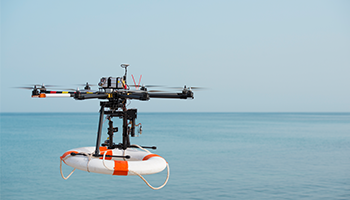Flying FPV drones makes use of an onboard camera that relays live video to goggles, mobile phones or tablet screens. Flying in FPV mode, you only have the vision transmitted from the drone’s onboard camera while the drone is out of your visual sight. This can limit your situational awareness and may lead to disorientation. You may not be able to manoeuvre the drone in time to prevent a collision and so create an unsafe situation for you or others.
Tip: Before you fly your FPV drone with goggles, you should first learn to fly your drone while you are watching it directly.
Use cases for FPV
 |
Freestyle and organised racesDrone racing and freestyle acrobatics. This turns flying drones into a sport. Drone pilots wear a head-mounted display in the way of special goggles (or even mobile phones adapted as goggles) that connect directly to a camera on board the drone they are flying. This camera transmits a livestream feed from the drone to the goggles’ headset. So is as if the pilot is on the drone itself. |
 |
Search & Rescue (SAR)Search and Rescue (SAR) has also become an increasingly utilised drone application thanks to the development of FPV technology. This allows search and rescue teams to locate injured parties in remote areas that may be difficult to access. |
 |
Agriculture operationsFor agriculture operations, dedicated FPV feeds capture data and images and enable easier and safer crop spraying as the pilot can automate the flight while monitoring the live FPV feed. |
Authorised flying with FPV goggles
The European Drone Regulation (EU) 2019/947 allows you to fly an FPV drone in both the open and specific drone categories without keeping direct eye contact with the drone, either freestyle or in a club, provided you follow some rules.
FPV drone on your own - freestyle
|
FPV in clubs
|
In their videos, ‘Drone Master - Introduction to FPV Drone Flying’ and 'Flying an FPV drone' the DroneMasters Junior Academy show you what flying FPV looks like.
Thank you DroneMasters for sharing !
The role of the Visual Observer
When you are flying with your goggles on, you can’t keep direct visual contact with the drone. The regulation still allows you to fly, but you will need to have a person next to you, an observer who is keeping their eyes on the drone. The visual observer's task is to watch the drone and scan the area around for any potential danger situations and to make sure you do not endanger other parties (e.g. aircraft, particularly helicopters, other drones, trees, birds buildings or people).
Proximity to pilot |
It is important that the visual observer is alongside the remote drone pilot and not far away. |
Clear communication |
observer must be able to communicate unimpaired with the pilot and give clear instructions on how to avoid a potential danger situation and, if needed, advise immediate landing to avoid collision. |
Observer’s qualifications |
The visual observer must be familiar with the rules but there are no qualifications needed for him/her. |
Keeping you and others safe – location scouting
Regardless of whether you are racing in a club or flying Visual Line of Sight (VLOS) freestyle, one thing you need to do when you arrive on your flying spot is location scouting.
You need to make sure that area is safe to fly in, that no obstacles or people (except those involved with your activity) are present in the area where you’re flying. If there are other people present, you need to instruct them about possible risks and give them clear instructions on how to react in case of an emergency.
Geographical zones – airspace for your drone
Drone geographical zones are certain portions of airspace that facilitate, restrict, or exclude drone operations. The zones address risks pertaining to safety, privacy, protection of personal data, security and the environment. Here a list of some of the restricted zones:
- Airports & airfields
- Hospitals
- Nature reserves
- Prisons
- Industrial installations
- Important buildings
For more information, contact your National Aviation Authority for more details in your country.
Drone operators & pilots
We summarised all you need to know about how to register your drone/s as an operator and what to do to become a safe drone pilot in our article ‘Drone operators & pilots’.
However, the drone regulation allows the possibility for NAAs to recognise registrations through model clubs and associations. This means if you join one club or associations, they can register you on your behalf.
Your most frequently asked questions on drones
EASA listens carefully to the drones community and wants to foster a better understanding of the EU regulations for drones. We maintain a comprehensive repository of FAQs to help you with your queries.
- Visit us on EASA Pro to see our FAQ catalogue on drones:
- Take a look at the European Drone Regulation (EU) 2019/947 which gives clear information on the legal situation for First Person View (FPV) drone flying.
